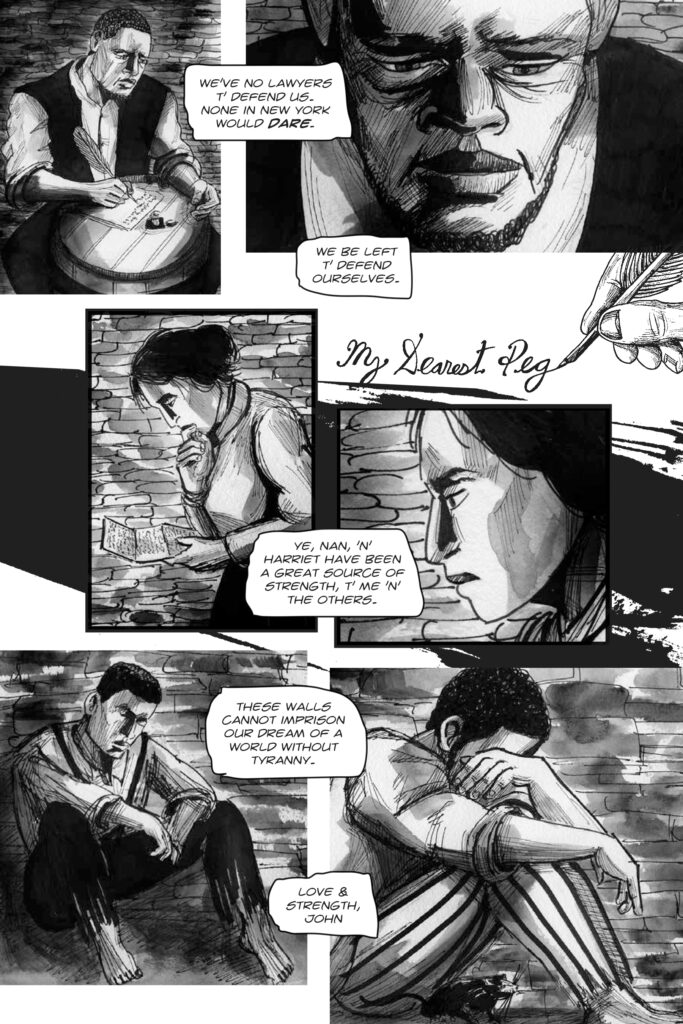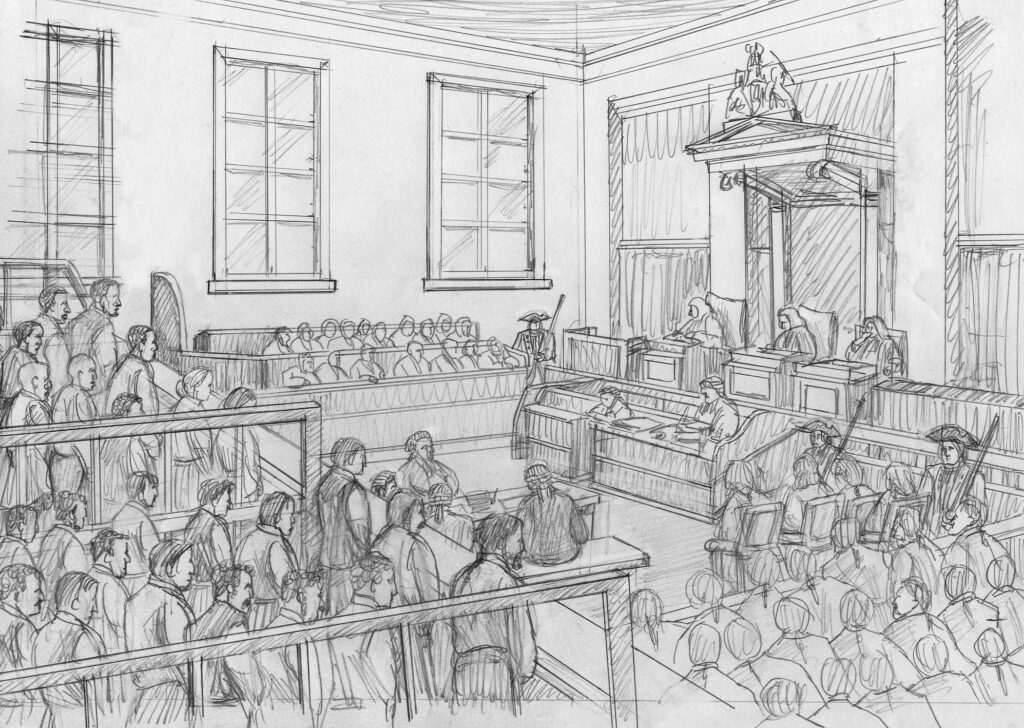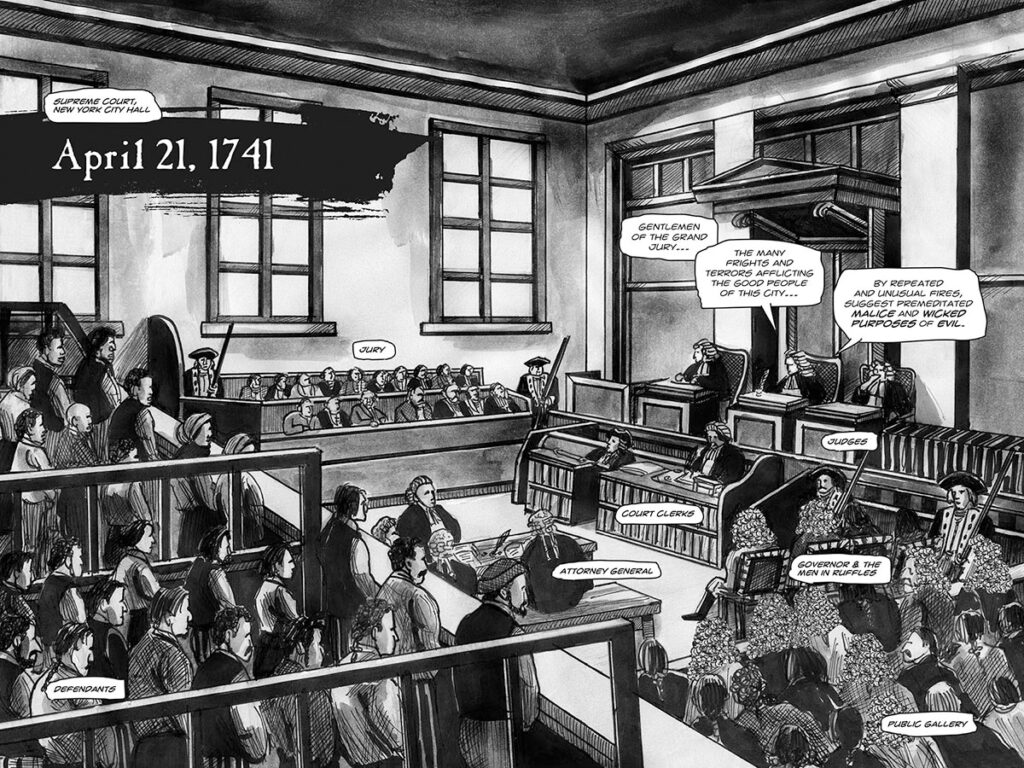‘Our weapon of liberation’
Revolution by Fire: New York’s Afro-Irish Uprising of 1741, A Graphic Novel
by David Lester and Marcus Rediker with Paul Buhle
Boston: Beacon Press, 2024
$18.95 / 9780807012550
Reviewed by Ron Verzuh
*

Following Prophet Against Slavery, Vancouver artist and punk musician David Lester has travelled back into American history to illustrate an inspiring event using his characteristic bold black and white images. Once again, as with his previous graphic novels, he offers readers a lesson in “history from below” about how ordinary people can rally against tyranny.
This time he uses the story of a 1741 New York uprising that was documented by historians Peter Linebaugh and Marcus Rediker in The Many-Headed Hydra: Sailors, Slaves, Commoners, and the Hidden History of the Revolutionary Atlantic.
Lester has seized on the story of a motley crew of revolutionaries that has been largely overlooked because, as the authors argue, historians tend to focus on “the white, male, skilled, waged, nationalist, propertied artisan/citizen or industrial worker.” This tendency has “hidden the history of the Atlantic proletariat of the seventeenth, eighteenth, and early nineteenth centuries.”
Lester’s job is to direct a light toward that proletariat. He illustrates their grim circumstances and the reasons for a planned revolt of “Africans, Irish soldiers and mixed-race sailors.” Their goal was to overthrow the colonial ruling class in New York and create a workers’ paradise. The going is tough, but Lester’s stark images and sparse dialogue energize the historic moment.

The book is divided into three parts. Part 1, The Conspiracy takes us to Hughson’s Tavern where we meet John Hughson, leader of the impoverished gathering. He will inspire them to grasp their own agency. “Fire will be our signal,” says one rebel, “and our weapon of liberation.” Here we learn how the young women have joined the conspiracy, having suffered and survived lives of prostitution. We also witness a budding love story.

Part 2, The Uprising takes us into the fiery heart of the story where Hughson, his love “Negro Peg” and their friends William Kane, Harriet, and Cuffee conspire with various secret societies to “plunder the rich under the protection of our own courage.” But the plot is undermined when Quack jumps the gun and sets fire to Fort George. Lester’s depiction of hand-to-hand combat reveals the brutal violence in a style that evinces emotion as “the city throbbed with panic and hysteria, excitement and hope.”
In Part 3, The Trial, the revolutionaries are brought before the Supreme Court of New York to face charges that they fomented a “detestable and felonious conspiracy to procure, abet, counsel, and encourage negroes and persons to said deeds.” The revolutionaries reject colonial laws and are found guilty after being betrayed by Mary Burton, a maid at the tavern. In a scene that pops off the page, some are sentenced to be burned at the stake. Twenty one others face hanging.


In the Epilogue, Lester returns to his storyteller, the daughter of Hughson and Peg. Fifty years have passed and revolution is again in the wind. This time it is Toussaint L’Ouverture leading a Haitian revolt against the French colonial powers. “We are the keepers of the common story,” she says.

Readers may find some of the language clipped, but it is a necessary shorthand. Lester had no time or space to expand on the revolutionary ideas and political concepts that are depicted graphically. Those seeking more detail may wish to consult Rediker and Linebaugh’s study.
As graphic novels go, this one is shorter than some and bolder than others. The cover alone is an eye-grabber, with Lester merging blazing red fire with the black faces of those at the centre of the revolt. It is also more Marxist in tone; it “focuses on power, oppression and resistance,” explains co-author Marcus Rediker in his Foreword.

Historian Paul Buhle, who has participated in several graphic novel projects, compares Lester’s work to that of classic artists like Rembrandt, Breughel, and Goya. German artist Kathe Kollwitz, who exposed Nazi horrors, also gets a mention in Buhle’s Afterword.
A prolific left historian, Buhle asked Lester what motivates him to create his powerful images. “To draw progressive history from below, I feel, requires a style that is as rough as the history being depicted,” he replied. “For me, the imperfections and messy nature of social change, and of revolution, benefit from being conveyed through a drawing that is raw and bold.”
In Fire by Revolution, he has accomplished that goal with his latest “art from below.”
Note: Also of interest to graphic novel readers is Lester’s earlier novel was about Benjamin Lay, a revolutionary dwarf who took on the slave-owning Quaker elders in eighteenth-century America and pressed the cause of racial freedom to the world community. A second novel takes us back to Canadian left-labour history in 1919: A Graphic History of the Winnipeg General Strike, by Lester and the Graphic History Collective.

*

Ron Verzuh is a writer and historian. [Editor’s note: Ron has recently reviewed books by David Spaner, Ken McGoogan, Dietrich Kalteis, Grant Lawrence, Howard White, Eileen Delehanty Pearkes, and Vince R. Ditrich for BCR.]
*
The British Columbia Review
Interim Editors, 2023-25: Trevor Marc Hughes (non-fiction), Brett Josef Grubisic (fiction and poetry)
Publisher: Richard Mackie
Formerly The Ormsby Review, The British Columbia Review is an on-line book review and journal service for BC writers and readers. The Advisory Board now consists of Jean Barman, Wade Davis, Robin Fisher, Barry Gough, Hugh Johnston, Kathy Mezei, Patricia Roy, and Graeme Wynn. Provincial Government Patron (since September 2018): Creative BC. Honorary Patron: Yosef Wosk. Scholarly Patron: SFU Graduate Liberal Studies. The British Columbia Review was founded in 2016 by Richard Mackie and Alan Twigg.
“Only connect.” – E.M. Forster
One comment on “‘Our weapon of liberation’”